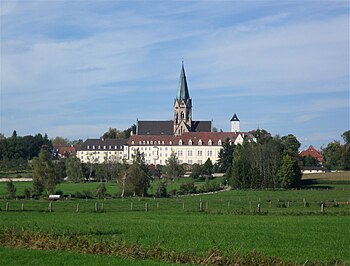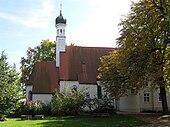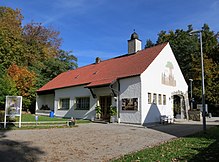Archabbey of Sankt Ottilien
Coordinates: 48 ° 5 ′ 49 ″ N , 11 ° 2 ′ 44 ″ E
The Archabbey of Sankt Ottilien (Latin Archiabbatia Sanctissimi Cordis Iesu ad Sanctam Ottiliam ) is a monastery of the Mission Benedictines in the Upper Bavarian district of Landsberg am Lech (near the Ammersee ), which belongs to the diocese of Augsburg . The monastery, together with the surrounding buildings, forms part of the municipality of Sankt Ottilien (until 1904 Emming ) of the municipality of Eresing .
The Archabbey is the parent monastery of the Ottilian Congregation . It was founded in 1884 by the Swiss Andreas Amrhein . The entire monastery association consists of 1,100 monks in 19 countries, of which around 110 live in St. Ottilien.
history
The pilgrimage to Saint Ottilia in Emming has been reliably documented since 1365. In the 16th century , Emming was expanded into a manor house. The Ottilien Chapel and a small castle were built. In the 17th century , the palace and chapel were redesigned in Baroque style. The estate changed hands several times over the years; the castle was demolished in 1884. Finally, Andreas Amrhein, a Benedictine of the Beuron Archabbey , acquired the abandoned hamlet in 1886 and founded Sankt Ottilien in 1887.
Motivation and beginnings of the start-up
Amrhein had his vision, Benedictine life with an insert in the mission to connect, within the Beuron Congregation can not be realized; therefore he started his own foundation independently of Beuron. After the first foundation in Reichenbach in 1884, the community was relocated to Emming in 1887. The monastery was named after the pilgrimage site Sankt Ottilien (the place name Emming was given up in 1904). Also in 1887 a first group of monks was sent to Africa as missionaries .
Development of the monastery
In 1902, Sankt Ottilien was elevated to an abbey. After founding three other abbeys, Sankt Ottilien became the Archabbey of the Mission Benedictines in 1914 ; Since then - from 1914 to October 2012 - the Archabbot of Sankt Ottilien was also always head of the Benedictine Congregation of Sankt Ottilien .
Until 1930 the monastery grew strongly (further mission areas South Africa , Korea , China ). Sankt Ottilien was expanded during this time to accommodate the convent, which had grown to 396 monks . In 1941 the monks were expelled from the German administration, which set up a military hospital there. After the end of the war until 1948 there was a DP camp in Sankt Ottilien , founded by the Lithuanian doctor Zalman Grinberg , in which prisoners liberated from concentration camps were taken care of. Immediately next to the monastery cemetery is a Jewish cemetery in which 76 dead were buried. The history of the DP camp is told and digitally documented using twelve stations spread across the site - including memories of the liberation concert by former Jewish prisoners on May 27, 1945 and the birth of 428 children between 1945 and 1948.
In addition to the tasks in the mission and the associated development aid in third world countries , the monastery runs a large retreat house , its own EOS publishing house , an impressive farm , the Rhabanus-Maurus-Gymnasium Sankt Ottilien for around 700 students with an attached day care center and boarding school and several artisanal businesses. The monastery also operates a small sports field and a youth campground.
According to the census on May 25, 1987, the district of Sankt Ottilien had 307 inhabitants in five buildings with living space and nine apartments.
Superior General and Archabbots
- Andreas Amrhein (1884–1895) (Superior General)
- Ildefons Schober (1896–1902) (Superior General)
- Norbert Weber (1902–1930) (1st abbot, archabbot from 1914)
- Chrysostomus Schmid (1930–1957)
- Suso Brecht (1957–1974)
- Viktor Josef Dammertz (1975–1977)
- Notker Wolf (1977-2000)
- Jeremias Schröder (2000–2012)
- Wolfgang Öxler (since 2012)
building
Exam area, guest house, retreat house, Gut Emming and Ottilien chapel
The cloister area was built in neo-Gothic style according to the plans of the monastery founder . Construction began in 1892. As early as 1910, the rapid growth of the community made it necessary to build another wing, which is in Art Nouveau style and is located south of the monastery church. The architect was Michael Kurz . The Mission Museum, established in 1911, is located in this wing . Since 1955, a wing with living cells, administrative rooms and a guest area has been attached to the west.
The "Ottilienheim", which serves as a guest house, is located near the monastery church. The retreat house opposite the front side, which was built directly onto the remains of the former Emming estate, is also used to receive guests. This old, pre-monastery part of the building connects to the baroque Ottilien chapel. The retreat house was initially only used for retreats in summer and in winter accommodated the students of the agricultural school that was previously located there.
Church of the Sacred Heart
The monastery church ( patronage Herz Jesu ) was built from 1897 to 1899 according to plans by Hans Schurr . Its pointed, 75 meter high tower can be seen from a great distance. The three-nave church was built in the neo-Gothic style and consecrated in 1903. The church was built - probably due to protests from the surrounding parishes - one vault shorter than originally planned.
Organs
Since 1994 the church has housed two instruments from the renowned Hubert Sandtner organ building workshop (Dillingen ad Donau): A main organ with three manuals and pedal (47 registers ) and a choir organ with two manuals and pedal (17 registers). The main and pedal parts of the choir organ are on the east gallery of the north arm of the transept, the swell on the opposite side on the west gallery of the transept. From the console of the choir organ it is possible to have certain fixed combinations of the main organ sound.
Main organ

|
|
|
|
|||||||||||||||||||||||||||||||||||||||||||||||||||||||||||||||||||||||||||||||||||||||||||||||||||||||||||||||||||||||||||||||||||||||||||||||||||||||||||||||
Choir organ
|
|
|
|||||||||||||||||||||||||||||||||||||||||||||||||||||||||||||||
Bells
In the church bell chamber, which is clad with wooden sound shutters, there is a nine-part loud chime, which is one of the lowest bell ensembles in southern Germany. It is also the lowest pitch of the bishopric of Augsburg . Eight church bells were cast by Karl Czudnochowsky ( Erding ), the great Hosanna in 1949 was the only one made of "Euphon" (copper-zinc alloy), the other bells in 1950 made of bell bronze . The gap between the Ulrich and Burkard bells was closed in 2019 with the new "Witnesses of Faith" bell, which was cast in the Grassmayr bell foundry and sounds in the tone a. All bells hang on straight yokes in the wooden bell chair. The detailed ringing order takes into account the variety of musical combinations of the bells. Fixed chiming appointments during the week are the ringing of the Angelus in the morning, at noon and in the evening with the Annuntiata , the memory of the Mount of Olives prayer and the agony of Christ on Thursday evening with the Gloriosa as well as the memory of the death of Christ on the cross on Fridays at 3 p.m. with Gloriosa and Ottilia (at every 1st Friday of the month with Hosanna and Annuntiata ). The full bell can only be heard on the highest festive days (Festum Summum): Christmas Eve and Christmas Day , Epiphany , Easter Vigil and Easter Sunday as well as Pentecost Sunday . The bell rings in the Clunyacensic style: 30 minutes before the beginning of the pontifical mass, all bells ring together; the smaller bells then ring out until finally only the hosanna sounds alone. One after the other, all eight bells are rung individually until the small chapter bell sounds. The other, larger bells now come back one after the other until the overall ringing sounds again.
|
No. |
Surname |
Nominal ( HT - 1 / 16 ) |
Weight (kg) |
Ø (mm) |
Liturgical function (soloist) |
| 1 | Christ Salvator (Hosanna) | f sharp 0 +1 | 5250 | 2180 | Festum Summum, men's high festivals, death bell for monks, angelus (Easter Sunday, Christmas Day, March 25th) |
| 2 | Benedict (Gloriosa) | a 0 -1 | 3600 | 1830 | Sundays during Easter and Christmas, Easter and Christmas octaves, Marian and Holy Feasts |
| 3 | Assumpta (anniversary bell) | h 0 -1 | 2250 | 1580 | Sundays in the annual cycle, Sundays during Advent and Lent, Angelus (Easter time) |
| 4th | Annuntiata (angelus bell) | cis 1 ± 0 | 1750 | 1430 | Angelus, Easter and Christmas working days, death bell for residents of the monastery village |
| 5 | Ottilia | e 1 +1 | 1050 | 1190 | Working days in the annual cycle and the Lent period |
| 6th | Bartholomäus (Apostle Bell) | f sharp 1 +1 | 650 | 1020 | Weekdays in Advent |
| 7th | Ulrich | g sharp 1 +1 | 450 | 880 | Noon shore |
| 8th | Witnesses of faith | a 1 +1 | 460 | 896 | Completely in the Easter and Christmas season as well as on high festivals |
| 9 | Boniface (chapter bell) | h 1 +1 | 350 | 800 | Completely |
The five largest bells bear the following inscriptions:
- Apparuit gratia Dei Salvatoris Nostri omnibus hominibus. Salvator Cor sacratum / flagrans atque vulneratum / hoc in loco sit laudatum / incessanter et amatum. Hosanna. Jesus, Salvator, salva nos. Hosanna / Hosanna. Salva nos Salvator. Hosanna. ("The grace of God, our Redeemer, has appeared to all people. Sacred Heart of the Redeemer, glowing and wounded, be praised and loved always in this place. Hosanna, Redeemer Jesus, save us. Hosanna.")
- Gloriose confessor domini monachorum pater et dux Benedicte intercede pro nobis. ("Glorious confessor of the Lord, father and teacher of the monks, stands up for us.")
- Assumpta est Maria in cælum gaudent angeli - In memoriam definitionis dogmaticæ assumptionis B. Mariæ V. Kal. Nov. Anni Sancti MCML. ("The angels are happy: Mary has been taken into heaven - In memory of the proclamation of the dogma of Mary being taken into heaven. On November 1st of the Holy Year 1950.")
- Ave Maria gratia plena. ("Hail Mary, full of grace.")
- Sancta Ottilia lumen posce patrona cæcis. ("Holy Ottilia, you our patroness, implore light to the blind.")
Monastery fire brigade
Monastery study
The monastery took part in the monastery study . According to the results, nuns and women of the general population live almost equally long, closely followed by monks who have an average life expectancy of one to two years shorter than both groups of women. Well behind are men of the general population who live an average of six years shorter than nuns and women of the general population and up to four and a half years shorter than monks.
Transport links
From the 1870s there were plans for a railway line from Mering to Ammersee and to Weilheim , which was to be run two kilometers east of the Sankt Ottilien monastery via Türkenfeld . However, the monastery campaigned for a route directly via Sankt Ottilien. Since it gave up the necessary reason for it, the railway construction committee finally decided on this route. On June 30, 1898, the route known as the Ammerseebahn , which runs east along the monastery, was opened. Sankt Ottilien got its own stopping point with a loading platform. It is the only train station in Germany that has only served to connect a monastery since its opening and until today. The reception building , newly built in 1939, is a listed building .
See also
- List of monasteries
- The Martyrs of Tokwon Territorial Abbey - Mission Benedictines ( Biographies of the Martyrs )
Remarks
- ^ All locations in the municipality of Eresing at the Bayerische Landesbibliothek Online
- ↑ Brochure from the monastery from 2009
- ↑ Augsburger Allgemeine from May 5, 2018 on the DP camp , accessed on June 8, 2018
- ↑ Article by Anton Posset from special issue 6 The future emanated from the Landsberg DP camp - Jewish DPs in the Benedictine abbey by Dirk Walter: The Jewish DP camp and hospital in Sankt Ottilien and the contemporary witness report by Erika G. Grube Movement therapist in the DP Hospital - A witness report
- ↑ see page about the cemetery at Alemannia Judaica at http://www.alemannia-judaica.de/st_ottilien_friedhof.htm
- ^ Official register of places for Bavaria, territorial status: May 25, 1987, Munich, 1991, p. 101
- ↑ Wolfgang Öxler elected Archabbot of St. Ottilien, orden-online.de, December 17, 2012
- ↑ The bells of the Archabbey of Sankt Ottilien ( Memento from August 21, 2008 in the Internet Archive )
- ↑ Bells of the Archabbey of Sankt Ottilien. In: The extensive chimes of the Archabbey of Sankt Ottilien is presented by Brother Lazarus on YouTube. Retrieved September 23, 2018 .
- ↑ Marc Luy : Why women live longer . Findings from a comparison of the monastery and general population. In: Materials on Population Science . No. 106 . Federal Institute for Population Research , 2002, ISSN 0178-918X , DNB 965668789 ( bib-demografie.de [PDF; 1.5 MB ; accessed on December 6, 2015] Zugl. Diploma thesis 1998). online PDF file, 1.5 MB ( Memento from December 6, 2015 in the Internet Archive )
- ↑ Marc Luy in: Hella Ehlers, Heike Kahlert , Gabriele Linke, Dorit Raffel, Beate Rudlof, Heike Trappe (eds.): Gender difference - and no end? Social sciences and humanities contributions to gender research . 1st edition. tape 8 . LIT Verlag, Berlin / Münster 2009, ISBN 978-3-8258-1647-6 , 10 years monastery study - knowledge gained and open questions about the causes of the different life expectancy of women and men, p. 251–273 ( limited preview in Google Book search).
- ^ Andreas Janikowski: The Ammerseebahn. Traffic development in western Upper Bavaria . Transpress, Stuttgart 1996, ISBN 3-344-71033-8 , pp. 51-54 .
literature
- Bals, Claudius: The Archabbey of St. Ottilien. Missionary monasticism. St. Ottilien 2004, ISBN 3-8306-7189-X .
Web links
- St. Ottilien. In: Portal of the monastery, Rhabanus-Maurus-Gymnasium, publishing house and other monastery facilities, retreat house, RhabaNews, times of worship. Retrieved December 21, 2009 .
- Bells of the Archabbey of Sankt Ottilien. In: The Archabbey presents its extensive ringing order on YouTube.
- Archabbey of Sankt Ottilien, Congregation of the Benedictine Missionaries. In: Monastery. Retrieved December 21, 2009 .
- Archabbey of St. Ottilien live. In: Livestream of the prayers of the hours of St. Ottilien. Retrieved December 6, 2015 .
- Entry to Archabbey Sankt Ottilien on order online
- eos - Editions Sankt Ottilien. Archabbey of St. Ottilien, accessed on January 21, 2014 (website of the monastery's own publishing house).
- programm.ard.de (TV documentary 2019: "The children of the hour zero", film by Tilmann Kleinjung)








